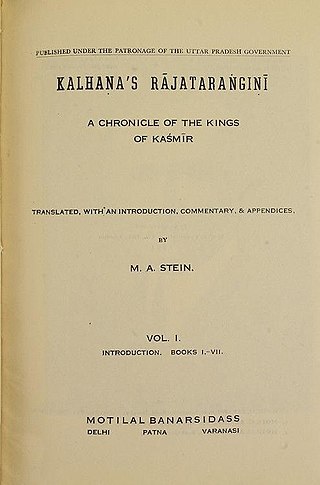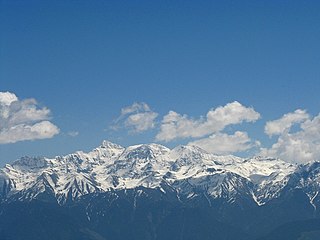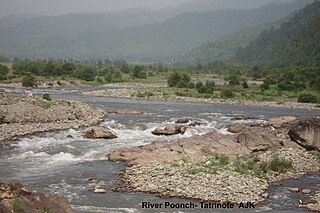
The history of Kashmir is intertwined with the history of the broader Indian subcontinent in South Asia with influences from the surrounding regions of Central and East Asia. Historically, Kashmir referred to only the Kashmir Valley of the western Himalayas. Today, it denotes a larger area that includes the Indian-administered union territories of Jammu and Kashmir and Ladakh, the Pakistan-administered territories of Azad Kashmir and Gilgit-Baltistan, and the Chinese-administered regions of Aksai Chin and the Trans-Karakoram Tract.

Rājataraṅgiṇī is a metrical legendary and historical chronicle of the north-western part of India, particularly the kings of Kashmir. It was written in Sanskrit by Kashmiri historian Kalhana in the 12th century CE. The work consists of 7826 verses, which are divided between eight books called tarangas ("waves").

The Pir Panjal Range is a chain of mountains in the Lower Himalayan region located in the Western Himalayas of northern Indian subcontinent. It runs southeast to northwest between the Beas and Neelam/Kishanganga rivers, in the Indian territories of Himachal Pradesh and Jammu and Kashmir, with its northwestern end extending into Pakistan. The Himalayas show a gradual elevation towards the Dhauladhar and Pir Panjal ranges. Pir Panjal is the largest range of the Lesser Himalayas. Near the bank of the Sutlej River, it dissociates itself from the Himalayas and forms a divide between the Beas and Ravi rivers on one side and the Chenab on the other. Further west, the Pir Panjal range separates the Kashmir Valley from the hills of Jammu region.

Rajouri or Rajpur is a district in the Jammu division of Indian-administered Jammu and Kashmir in the disputed Kashmir region. The Line of Control lies to its west, Poonch to its north, the Reasi district to the east and the Jammu district to its south. Rajouri is famous for its "Kalari". Representing an ancient principality, Rajouri was a joint district, along with Reasi, at the time of princely state's accession to India in 1947. The two tehsils were separated and Rajouri was merged with the Poonch district. Rajouri again became a separate district in 1968. The Rajouri district comprises 13 tehsils (boroughs). The land is mostly fertile and mountainous. Maize, wheat and rice are the main crops of the area and the main source of the irrigation is the river Tawi that originates from the mountains of Pir Panjal.

Shah Rukh Shahi Khan, popularly known as Ghiyas-ud-Din Zainu'l-Abidin or simply Zainu'l-Abidin, was the ninth and eleventh Sultan of Kashmir, who reigned first from 1418 to 1419 and then from 1420 to 1470. He was famously called Budshah by his subjects.

Banihal local pronunciation [banhal] is a town and a notified area committee, near Ramban town in Ramban district in the Indian union territory of Jammu and Kashmir. It is a rural and hilly area with Kamirwah being one of the most prominent hills. It is located about 35 km (22 mi) away from Qazigund of Anantnag district on NH 44. However, the distance between Banihal and Qazigund is only 18 km by train on the new railway line which is much shorter than the road. The most common language spoken in the region is Kashmiri; Urdu, Hindi, Gujjari, Pahari and English being other familiar languages. Banihal forms the main gateway to the valley of Kashmir. Some famous visiting places in banihal are Neel top and Mahu valley.

Shopian or Shupiyan, known as Shupyan in Kashmiri, is an administrative division of the Shopian district, located in southern part of Kashmir Valley, of Jammu and Kashmir, India. Shopian is called the ''Apple town of Kashmir'' as majority of the population engages in apple growing practices which also provides employment to more than 60% of the population. It is 2nd richest district in Kashmir region after Srinagar.

Didda, also known as The Catherine of Kashmir, was the ruler of Kashmir from 980 CE to 1003 CE. She first acted as regent for her son and various grandsons from 958 CE to 980 CE, and from 980 CE as sole ruler and monarch. Most knowledge relating to her is obtained from the Rajatarangini, a work written by Kalhana in the twelfth century.

Poonch, is a town and the administrative headquarters of the Poonch district, of the Indian-administered union territory of Jammu and Kashmir, which is part of the larger disputed territory of Kashmir. It is located near the Line of Control – the de facto border in the disputed region. Poonch shares a de facto border with the Poonch district of the Pakistan-administered, self-governing territory of Azad Kashmir.

Mughal Road is the road between Bufliaz, a town in the Poonch district, to the Shopian district, in the union territory of Jammu and Kashmir, India. The 84-kilometre road traces a historic route used in the Mughal period over the Pir Panjal Pass, at an altitude of 3,500 m (11,500 ft), higher than the Banihal pass at 2,832 m (9,291 ft).
The Battle of Shopian took place on 5 July 1819 between an expeditionary force from the Sikh Empire and Jabbar Khan, the governor of the Kashmir Valley province of the Durrani Empire. It was the decisive battle during the Sikh expedition into Kashmir in 1819.

The Poonch River is a tributary of the Jhelum River that flows through Jammu and Kashmir in India, and Jammu and Kashmir in Pakistan.
Surankote is a town in the Surankote Tehsil of the Poonch district of the Indian union territory of Jammu and Kashmir. It occupies the Surankote valley, located between the Pir Panjal and ranges within the Himalayas. It receives snowfall in winters. It is famous for the existence of lakes on the Pir Panjal range which are not still connected with the outside world. Although some people visit these lakes by foot for recreation and refreshment.

Hirpora Wildlife Sanctuary or Heerpora Wildlife Sanctuary is located, Hirpora in Shopian district of Jammu and Kashmir. It lies 12 km from Shopian town, 70 km (43 mi) south of Srinagar. It spreads over an area of 341 km2 (132 sq mi). It is bounded to the north by Lake Gumsar, northeast by Hirpora village, east by Rupri, south by Saransar and to the west by the Pir Panjal pass. The slopes are gentle to moderately steep on the eastern aspect and very steep with many cliffs on the higher northern and western aspect. The southern and southeastern portions are moderately steep. Heerpora wildlife sanctuary is one of the beautiful wildlife sanctuary in Jammu and Kashmir

Tosa Maidan is a tourist destination and a hill station in the khag area of the Budgam district in the Kashmir Valley of the Indian union territory of Jammu and Kashmir. The name also marks the historic Tosa Maidan route into the Kashmir Valley from the Poonch Valley. In fact, the original name of Tosa Maidan appears to have been "Tosa Marg". Mahmud of Ghazni and the Sikh monarch Ranjit Singh attempted to invade the Kashmir Valley via this route.

Khag is a tehsil in and block in the Beerwah sub-district of the Budgam district in the Indian union territory of Jammu and Kashmir. It is 8.8 km (5.5 mi) away from sub-district headquarter Beerwah and 35 km (22 mi) away from Srinagar, the summer capital of Jammu and Kashmir.

Noori Chamb is a waterfall in the headwaters of the Poonch River in Poonch district of Jammu and Kashmir in India. It is named after the Mughal queen Nur Jahan.
The Chak or Chaq dynasty was a Kashmiri dynasty of Dardic origin that ruled over the Kashmir sultanate in medieval Kashmir after the Shah Mir dynasty. The dynasty rose to power in 1561 in Srinagar after the death of the Turco-Mongol military general, Mirza Haidar Dughlat when Ghazi Shah assumed the throne by dethroning Habib Shah, the last Shah Mir Sultan. The dynasty ended in 1589 when Yakub Shah surrendered to Akbar.

The Pir Panjal Region is a region located in the southwestern part of the Pir Panjal Range in the Jammu Division of the Indian-administered union territory of Jammu and Kashmir. This name particularly refers to the districts of Poonch and Rajouri.




















